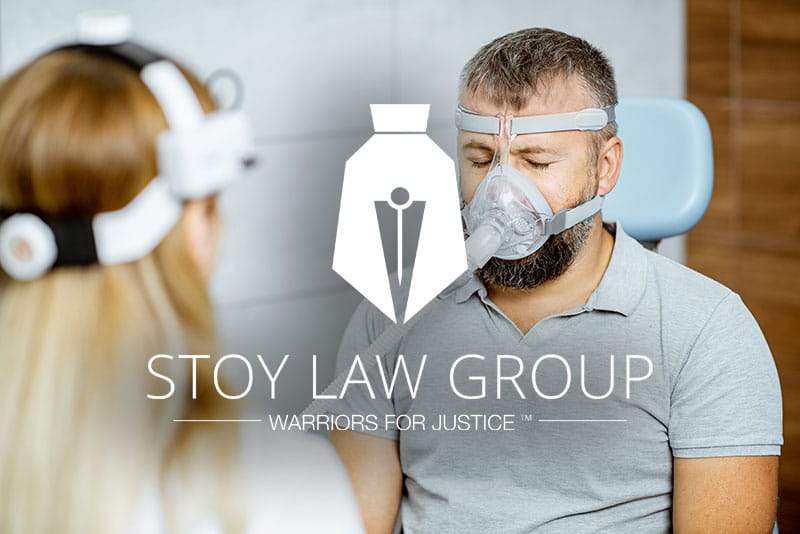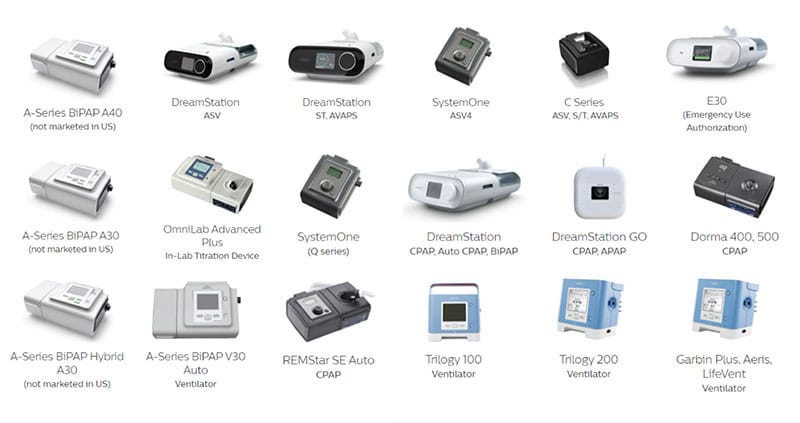There is ongoing litigation to determine to what extent the healthcare device company Phillips caused damages to patients using their CPAP machines. These machines, rather than assisting in sleep aid, instead potentially exposed these people to harmful chemicals.
What is so critical about these CPAP machines?
What is the current status of these lawsuits?
Let’s look at the history of this litigation to see the extent of the damages and if it is still too late for a new plaintiff to join in.
What Is Sleep Apnea?
Sleep apnea is a medical disorder that affects your breathing while asleep. If you have sleep apnea, your body has difficulty breathing while you sleep, stopping and starting throughout the night.
This condition occurs due to an obstruction caused by the throat muscles. Or, it can be the result of misfiring signals from the brain while sleeping.
Symptoms of Sleep Apnea
The symptoms of sleep apnea are not unique to the condition. It also does not help that not everybody experiences the same set of symptoms. Because of that issue, sleep apnea can be hard to diagnose.
Folks that suffer from sleep apnea tend to experience one or more of the symptoms:
- Loud snoring
- Periods of not breathing or gasping for air during sleep
- Waking up with a dry mouth or moderate to severe headaches
- Insomnia
- Daytime sleepiness (hypersomnia)
- Difficulty focusing or paying attention when awake
- Irritability while awake
Sleep apneas only exhibit themselves while the patient is asleep. It takes an outside party to report many of the symptoms. Spouses, partners, and family members can help somebody with sleep apnea. This help can come from them pointing out the symptoms to the person with sleep apnea when they wake up.
Sleep studies can also help diagnose sleep apnea. In the studies, the patient is monitored while they sleep by sleep and health professionals. Sensors and electrical readings generated while the patient sleeps can give these professionals the data needed to make a proper diagnosis.
Sleep Apnea Causes and Risk Factors
Not all sleep apnea is caused by the same issues. There are three main types of sleep apnea is that exist:
- Obstructive sleep apnea: The most common kind of sleep apnea involves the throat muscles relaxing, obstructing the airway.
- Central sleep apnea: This type of sleep apnea happens when the brain and nerves do not signal properly to the muscles that control breathing while asleep.
- Complex sleep apnea syndrome: The rarest form of sleep apnea involves both a combination of obstructive and complex sleep apnea to further obstruct the airway.
Right now, there are estimates that one in fifteen people suffer from sleep apnea of some kind.
There isn’t one specific risk factor that increases your chance of having sleep apnea, though. Instead, there are a host of factors that can affect your chances. These factors are different between the obstructive and central forms of sleep apnea.
For obstructive sleep apneas, the risk factors are:
- Excess weight: Obesity increases your chances of having apnea by increasing the weight on your upper airway.
- Larger neck circumference: In general, this can indicate a narrower airway.
- Being male: Men have an increased chance of having this condition.
- Being older: The elderly population tends to have more relaxed throat muscles that can obstruct their airway while sleeping.
- Family history: Narrow airways can be inherited down family trees, increasing the chance of obstructive apnea.
- Alcohol, sedative, or tranquilizer use: All of these relax the muscles, including the throat.
- Smoking: Smoking increases inflammation in the throat, which can restrict airways and cause obstruction while sleeping.
- Medical conditions: Cardiovascular disease, diabetes, and Parkinson’s disease can increase the chances of an obstruction in your throat while sleeping.
Central sleep apneas share the male and elderly risk factors that obstructive sleep apneas have. However, other risk factors increase the chances of having central sleep apnea:
- Narcotic pain medicine use: Opioid medications increase the risk of sleep apnea by affecting nerve pathways in the throat.
- Having a stroke: A stroke can affect nerve pathways in the body, increasing the chances of developing central sleep apnea.
Having one of these risk factors does not guarantee that you will get or have sleep apnea. It just means that you are more likely to develop sleep apnea.

What Is A CPAP Machine?
If you are not familiar with the sleep apnea condition, this lawsuit might seem strange. What is a CPAP machine, and how do they help with sleep apnea?
A Continuous Positive Airway Pressure (CPAP) machine is a medical device used to keep the airway open while someone sleeps. By providing a constant positive pressure inside the throat, the airway stays open. This pathway lets air pass through into the lungs while the user is asleep.
By providing this open airway, the user of the machine can sleep better at night. The opened airway prevents snoring and lets the user fall into a deeper sleep, making their rest count for more.
How To Use A CPAP Machine
Properly setting up a CPAP machine is required to get the most out of the device. To set up a CPAP machine for use during the night, you would follow these steps:
- Find a place to set the machine: A stable place with electric power and allows the hose of the device to reach the user while asleep is needed.
- Check the filter: The replaceable filter inside the device needs to be seated properly and not clogged or dirty.
- Attach the hose to the CPAP machine: The hose that connects the nose piece to the CPAP machine will attach to one end of the device.
- Attach the hose to the mask: With the hose in the device, you can now run the hose to the mask and nose piece to place on your face later.
- Set up the humidifier: Most CPAPs have a water reservoir to humidify the air it puts out, so make sure the reservoir stays full of distilled water.
- Plug in the CPAP: Most at-home CPAP machines use a standard plug to draw power from the wall.
- Adjust the mask and turn on the machine: Move the straps of the mask to make sure the device fits snug onto your face before turning the power of the device on.
- Find a comfortable sleeping position: As long as you can fall asleep without blocking or kinking the hose of the CPAP machine, you are good to go for a night’s rest!
Once you go through the above steps once, you won’t have to do them all over again each night. As long as the reservoir and filter are maintained, you’ll only need to put on the mask, flip on the power, and go to sleep.
What’s the Difference Between CPAP and BiPAP Machines?
Bi-level Positive Airway Pressure (BiPAP) machines are similar to CPAP machines, but the air pressure they put out is different. Instead, a BiPAP machine adjusts the pressure it outputs depending on where you are in your breathing cycle.
When you wear a BiPAP machine and breathe in, the machine outputs a higher pressure to help push air into your lungs. When you exhale, the machine reduces its output pressure so that you are not fighting against the positive pressure of the device to exhale.
Why Are CPAP Machines Being Recalled?
The recall of Phillips CPAP and BiPAP devices is because of the degradation of the foam inside of the device. Many of these devices are built with a soundproofing foam that dampens the noise of the pump while it runs.
The specialized foam is a polyester-based polyurethane (PE-PUR). Grades, this foam breaks down into small particles. High heat and humidity, such as what is found inside the device while in use, speed up this degradation process and produce more particles.
These particles are then forced through the device through the high-pressure air system that keeps the airway open during rest. If the foam makes it into the system, there’s a chance that the patient can inhale or ingest the foam while the device is in use.
Some of the complications inhaling this foam can lead to are:
- Inflammation/irritation of the airway
- Irritation of the eyes, nose, respiratory tract, or skin
- Asthma
- Coughing
- Dizziness
- Headaches or hypersensitivity
- Nausea or vomiting
- Kidney or liver damage
- Lung damage or lung cancer
As with many exposure events, the longer a patient is subjected to this situation, the greater the likelihood of developing one of these complications. Many of these complications start with mild symptoms and grow into something worse over time.
To make matters worse, the filter inside of the CPAP machines put out by Phillips is not rated to filter out the particles produced by this foam.
What is the CPAP Lawsuit?
Despite having known about this problem for years, Phillips is now being subjected to class-action lawsuits to remove the faulty devices from the market.
These lawsuits also could potentially force the company to pay damages to those affected by the inhalation of this foam from their devices.
What Is The Latest News On the Philips CPAP Recall Lawsuits?
Currently, the Phillips BiPAP and CPAP lawsuit is still in the early stages.
The voluntary recall from Phillips only came through in June 2021, meaning that the company is still in the collection phase for its faulty devices. Also, prosecutors are still working with clients to determine the standing and damages related to the lawsuit. Many individuals have yet to file claims as well.
A class-action lawsuit, Shelton v. Koninklijke Philips N.V. et al., June 29, 2021. Within this class-action lawsuit, the causes of action were laid out:
- Negligent CPAP recall
- Strict liability for failure to warn
- Unjust enrichment
- Strict liability for defective design
- Negligent design defects
- Breach of the implied warranty of merchantability
- Breach of express warranty
- Negligent failure to warn
The class-action lawsuit also lays out a claim referencing a state law—the state law ties specifically into unlawful trade practices within Massachusetts.
There have not been any federal multidistrict litigation (MDL) formed so far. Still, thousands of individuals and patients suffered from these devices over the years, so one is expected.
Large numbers of affected individuals with similar injuries against the same entity help consolidate these legal proceedings into a singular court site, thus creating an MDL. MDLs such as this help with proceedings and discovery and their efficiency.
Attorneys and plaintiffs tend to prefer MDLs because of how damages are tailored to clients. Within MDL, the client receives a damage payout based upon their relative injury. This is different from the result of the class-action lawsuit, where each client gets an equal portion of the payout.
This specificity takes extra work, however. MDLs take longer to pay out damages to their clients because of the extra time and effort required to manage the specificity. If this is the direction the sleep apnea lawsuit goes, expect payouts to take longer than a typical class-action lawsuit normally would.
In this case, a Philips class action lawsuit seems unlikely. Many potential plaintiffs have brought evidence to suggest that Philips had time to remedy the situation sooner and chose not to do anything. Because damages differ between potential plaintiffs, a Philips class action lawsuit wouldn’t reward people hurt by Philips fairly.

Which CPAP Machines Have been Recalled?
Right now, the recalled CPAP machines have been makes and models associated with the Philips company. In June 2021, Philips voluntarily recalled these devices to ensure that the noise-dampening foam inside the devices doesn’t harm the people using them.
The currently recalled CPAP and BiPAP machines are:
- C Series S/T, AVAPS
- Dorma 400, 500 ​CPAP, Auto CPAP
- DreamStation ASV
- DreamStation CPAP, Auto CPAP, BiPAP
- DreamStation GO CPAP, APAP, Auto CPAP
- DreamStation ST, AVAPS
- E30
- OmniLab Advanced Plus
- REMstar SE Auto
- System One 50 series
- System One 60 series
- SystemOne ASV4
- SystemOne (Q-Series)
There are also mechanical ventilator machines under recall for a similar reason as the CPAP/BiPAP machines. Those ventilator machines under active recall are:
- A-Series BiPAP A30
- A-Series BiPAP A40
- A-Series BiPAP Hybrid A30
- A-Series BiPAP V30 Auto Ventilator
- Garbin Plus, Aeris, LifeVent Ventilator
- Trilogy 100 Ventilator
- Trilogy 200 Ventilator
Overall, this recall affects around four million devices.
Philips has worked with health care providers and institutions to get the word out about these devices. Part of this work has been sending out instructions on how to return the devices to the manufacturer and what to do once the device has been received.
How Do I Know If My CPAP Has Been Recalled?
If you see your CPAP machine in one of the lists above, your machine is under recall. You’ll want to discontinue using it as soon as possible.
If you’re not sure if your machine has been recalled, then contact your doctor and ask them. They will be able to check your records, including the device you were prescribed.
Is A CPAP Machine Recall Serious?
The CPAP recall has been labeled by the US Food and Drug Administration (FDA) as Class 1, which is the most severe categorization they can give. This is because the affected Philip CPAP machines can cause severe injuries or even death if left on the market.
These devices, which are supposed to provide breathing relief during sleep, contaminate and affect airways when people are most vulnerable.
The cause of these contaminants is coming from the foam inside of the CPAP machine. This foam, meant to dampen sound from the device running, degrades when exposed to heat and humidity.
This foam, made from polyester-based polyurethane, creates dangerous and volatile organic compounds toxic to the human body. Some of these compounds include toluene diamine, toluene thiocyanate, and diethylene glycol.
Also, this foam is more likely to degrade over time. The foams are rated for a certain lifespan, after which they begin to degrade faster.
People first became aware of the issues being caused by the Philip CPAP machines when it was reported that black debris was showing up in breathing tubes and air path circuits.
This black debris was a sign that the foam inside of the machine was beginning to break down. Being inside the airway hose, it was clear that people were inhaling this debris and associated organic compounds.
Initially, Phillips explained that unapproved cleaning processes would cause the foam to degrade. Things such as ozone or ultraviolet light treatments would worsen foam degradation. SoClean, the supplier of Phillips’ cleaning products for the CPAP machines, is currently suing Phillips for $200 million for this defamatory claim.
If you are using one of the recalled devices, you must return the device to Phillips for proper disposal and replacement.
Could Your CPAP Machine Be Making You Sick?
Because we are still in the early stages of the Philips CPAP lawsuit, the specific extent of the damages caused by the faulty CPAP machines is unclear.
We know that the machines are causing people to get sick and worse. We also know that millions of devices, and thus people, have been affected by this defect.
Clients associated with this lawsuit have reported a group of similar symptoms from their exposure to the degraded foam.
Some of those symptoms include:
- Upper airway irritation or infection
- Irritation of the skins, eyes, or throat
- Headaches and hypersensitivity
- Nausea and vomiting
- Liver or kidney damage
- Lung damage or lung cancer
What are the Signs that Your CPAP Machine is Defective?
An easy way to check to see if your CPAP machine is negatively affecting you is to check the airway hose of the device. You can also inspect the part of the mask where the hose connects to it. If you find any black particles or residue, that’s an indication that the foam inside is degrading and spreading throughout the machine.
If you can see the residue inside of the hose, you are most likely breathing in some amount of this residue. Because this residue is toxic, it will make you sick over time if you are not already.
This comes down to a combination of particle and chemical exposure. The particles of foam, when they break down, enter the airway and lungs and irritate them. Cells in your body fight to clear away these toxic particles when the inflammation starts to flare up, causing irritation and breathing troubles.
As this phone breaks down, it releases volatile organic compounds highly toxic to the human body. Over time, these chemicals can have carcinogenic effects on the body. Your liver and kidneys will do what they can to filter these out of your system, but they are also affected by these chemicals with enough long-term exposure.
This is why your lungs, livers, and kidneys all experience damage from these chemicals over time.

What To Do If Your CPAP Is Being Recalled
If you find out that your CPAP is being recalled, you should first contact your doctor. Most doctors will tell you to stop using the CPAP machine once they hear that you’re using a recall device.
These devices are a hazard to your health and do more harm than good in the state that they are in.
Can I Sue Philips Respironics?
If you think you qualify for damages based on the ongoing lawsuits, reaching out to a law professional can help.
There is a statute of limitations on filing a suit, so our attorneys will be able to help you determine if you qualify for the CPAP machine lawsuit. They’ll also be able to help you file your own suit or join in on any group litigation that is going on.
If you have any evidence of the foam degradation, such as a hose or mask with residue inside, hold onto it. This evidence, alongside any medical and prescription records, will be able to be used as evidence during the court proceedings. Photographs or videos of the debris are helpful as well.
Finally, expect to be involved in this suit for a long time. It’s only been a couple of months since the lawsuit was made public, and these sorts of proceedings tend to move slowly. In general, suits of this size can take a year or longer to work through the system and have damages be paid out.
Be patient, and work with your law professional to make sure that you are the reason why things get held up in your particular suit.
How Much Money Could You Get If You Sue?
Action that the suit is going, it’s expected that an MDL will roll out sometime soon. Because of this, payouts for any damages caused by Phillips will be handled on a case-by-case basis.
While patients that have experienced mild symptoms may not receive much, those who have been severely damaged by the oversight caused by Phillips could receive a large payout of six figures or more.
Currently, attorneys within the suit are fighting for compensatory damages in the following areas:
- Medical expenses
- Lost wages
- Loss of future earnings
- Pain and suffering damages
- Miscellaneous economic losses
The court can award a plaintiff punitive damages if it can be proven that Phillips knew about the PE–PUR foam degradation. If Philips also did nothing to resolve the issue promptly, then the court will order punitive damages.
As of right now, there is some evidence to suggest that customers have been complaining to Phillips for years about their exposure.
Phillips could be in further trouble based on their voluntary recall of defective CPAP machines. Evidence suggests that Phillips coordinated this recall to overlap with a new product launch of safer CPAP machines.
This practice would have forced customers reliant on CPAP machines to buy the new products at their own expense rather than having Phillips replace the defective products.
For example, the Dreamstation 2 model of CPAP machine was launched on April 13, 2021, just two months before the initial recall.
It is worth noting that punitive damages often exceed compensatory damages. Phillips can afford to pay out these damages, given that they currently have about 65% market share of the United States CPAP machine market. This market share is thanks to a combination of acquisitions and mergers over the last two decades.
Current CPAP Settlements
Right now, there have been no active settlements made in any of the Phillips CPAP machine lawsuits.
Evidence collection is ongoing for the mass litigation that is currently being formalized. Given that the courts have yet to decide where an MDL should be, it will be sometime before court proceedings begin, let alone any settlements.
For the time being, it is best to contact a law professional about the matter if you have been affected by the Philip CPAP machines. These professionals will help you determine to what extent you have been hurt or damaged by the device.
Because it has been five months since the initial launch of the recall, plaintiffs do not have much time left to join in the group litigation. If you want to partake in any settlement action, you will need to join sooner rather than later.
Do not be hasty in your rush to join, however. Work with a law professional to get everything done quickly and effectively. Mistakes made at this point could cost valuable time that could keep you from joining with others that Philips has hurt in the litigation and settlement processes.
Contact Stoy Law Group
While still somewhat new, the Philip CPAP machine lawsuits are reaching a critical point in their discovery.
Plaintiffs harmed by the Phillips company practices and lack of response are currently banding together to force Phillips to pay damages for healthcare devices that have instead caused harm.
If you or someone you know has been using a Phillips CPAP machine, their best course of action is to gather evidence and talk to an attorney that is handling CPAP cases.
From there, the professional will be able to work with them. Together, they can decide if it is worth pursuing litigation and what damages can be expected as payout if the case goes well.
If you have any questions about your potential CPAP lawsuit, contact our lawyers today.













